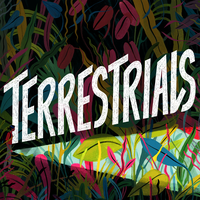The Gorilla in the Room

[RADIOLAB INTRO]
LULU MILLER: Three, two, one! Imagine the Terrestrials feed suddenly—roop!—comes back to life! [laughs] Well, it just did. It is happening right now before your very ears. I am so pleased to announce that as of this moment, this podcast feed, Radiolab for Kids, home of Terrestrials, will always be on. We are gonna be dropping episodes about nature, about animals, about plants every other week. Sometimes these will be brand new Terrestrials episodes full of songs and silliness. Sometimes they will be our very best, shiniest, furriest, family-friendliest Radiolab episodes about animals or plants or nature. You'll always get a little hello from me, and we hope that this feed will sort of start to feel like a nature walk—a place where you can show up and explore and always encounter something unexpected out there in the wilderness.
LULU: Which brings me to today's story. Today, we have a story about a gorilla. A gorilla who was kind of sad because he was stuck in a zoo. But things will not stay that way thanks to some very inventive humans. That's all I'm gonna say. I will let hosts Robert Krulwich and Jad Abumrad take it from here. All you need to know is that Jad does not like the zoo, finds it kind of icky and sad. And Robert? Well, he ...
ROBERT KRULWICH: I love the zoo. What about you?
JAD ABUMRAD: I don't know about the zoo, kind—of icky.
ROBERT: Why?
JAD: I just—I want the animals to not be there in the cage.
ROBERT: Be someplace, what, prettier, safer?
JAD: Safer, prettier. I'd rather watch them on TV frankly, and let them run around on their own.
ROBERT: [laughs] Well the guy—this is interesting—the guy who made the big move in modern zoo history ...
DAVID HANCOCKS: Hello? Hello?
ROBERT: That's him. His name is David Hancocks. We got him into a studio, and he's sort of a little bit like you. He was very ambivalent about zoos.
DAVID HANCOCKS: I'd actually for a while toyed with the idea of do I want to go and work in zoos and try to change them, or do I want to stay outside zoos and work to close them down? And I came to the conclusion that there's no way you're gonna close zoos down. The fascination of wanting to be close to wild animals cuts across every strata of society.
ROBERT: You know—this is my case, by the way—I love being close to them. Anyway, David Hancocks decided if you can't beat them you join them. And it was in the mid 1970s and David was working actually as an architect. He was between jobs when he got a call. A friend recommended him for a job at the Woodland Park Zoo in Seattle.
DAVID HANCOCKS: Yes. Yes.
ROBERT: And he gets hired.
DAVID HANCOCKS: I was in an unusually fortunate situation in that just after I was hired and got there the zoo director left.
ROBERT: And so there was nobody to run the place—well, except for David. So he decided to take a look at the entire philosophy of the zoo and change everything, starting with the gorillas. They lived in awful cages.
DAVID HANCOCKS: The—the gorillas were living in a small, concrete building.
ROBERT: It was a spare, empty concrete box with a glass window.
DAVID HANCOCKS: The gorillas of course were bored, and slowly going out of their mind.
ROBERT: Occasionally you'd find a gorilla who'd take his feces and smear it on the wall.
DAVID HANCOCKS: Yes. I mean, they had nothing else to interact with. The only natural components in his life that he ever came into contact with would have been the food that he ate and the feces he produced.
ROBERT: So cages were the problem. The solution, he decided—well, he wanted to rip up the cages, yank them out completely and replace them with—with something, a natural setting of some sort. But when he looked around for a model no zoo in the world had gorillas in what you would call a natural setting, and he wasn't even sure what is natural for, say, a gorilla.
DAVID HANCOCKS: There—there was very, very little known about gorillas and their wild behavior. In fact, all the books said that gorillas don't climb.
ROBERT: This was early in the '70s, remember, so David invited a person who did know.
DAVID HANCOCKS: I heard about Dian Fossey—Dian Fossey's work was beginning to be carried in National Geographic.
ROBERT: You know Dian Fossey.
JAD: Yeah, right. Right.
ROBERT: She lived with a group of gorillas, wrote down everything she saw, their social interactions and all, and was the gorilla expert at that time.
DAVID HANCOCKS: And I heard that she was coming to the US, and she agreed to come to Seattle and spend a couple of days with us. We were trying to get images from her of the sort of environment we could create. And the breakthrough came after the couple of days that she'd spent with us. I was driving her back to the airport and I said, "Is there anything you've seen around here or anywhere in this part of the world that in any way resembles the sort of places where you've seen gorillas in the wild?" And she just pointed to this verge on the freeway.
ROBERT: I don't know what a verge is. What's a verge?
DAVID HANCOCKS: A ver—oh sorry, you—what—the—the landscape on the side of the freeway, the sloping, what—what would you call it?
ROBERT: I would call it—if it were President Kennedy I would call it a—what do they call it?
DAVID HANCOCKS: A knoll?
ROBERT: Yes, a knoll. But I wouldn't call it that because only President Kennedy gets that.
DAVID HANCOCKS: No.
ROBERT: I would call it the green stuff on the side of the road.
DAVID HANCOCKS: Okay, yeah. It was a banked area that had once been cleared, and then this verdant growth that you get in Seattle was springing back. And she said, "That right there, that's where I would expect to see—to be observing gorillas in the wild." So I dropped her at the airport, came back, and on the way back illegally parked on the side of the freeway and took photographs and then said, "Here. This is what Dian Fossey said we should be designing." [laughs]
ROBERT: So as you can tell, they had absolutely no idea what they were doing, but they also didn't have a boss, and within a few months, with help from a landscape architect ...
GRANT JONES: Hi, I'm Grant Jones from Seattle, Washington.
ROBERT: ... they drew up a plan and out came the bulldozers.
GRANT JONES: Exactly. And we were creating huge mounds and hills about 10 or 15 feet high. Some rocky cliffs along one side, some creek—trees. Shrubs about three or four feet high, big herbs and vegetables and tangles of vines, undergrowth. Lots of laurel bushes. Hawthorne trees, some big humphrey leaves that we planted that have long berries and pointed drip tips, tropical-like leaves, fast-growing pioneer plants.
DAVID HANCOCKS: We just let it grow wild.
ROBERT: Now nobody was watching you.
DAVID HANCOCKS: And nobody was watching us and that was the critical factor, I think, yes. Because if a traditional zoo director had seen or heard what we were doing they would—he would have stopped it.
JAD: And—and why—why would a traditional zookeeper have stopped this?
ROBERT: Well, because they were worried about what—like, suppose you had been a gorilla and you'd spent your whole life living in a cage, in a concrete cage.
JAD: Right.
ROBERT: Now I'm gonna take you, little Jad, my baby gorilla, and stick him into a completely new place with sky and jagged things. I mean, I would be worried that you'd hurt yourself.
VIOLET SUNDE: In the zoo world, generally I think people were very nervous about it.
ROBERT: That's Violet Sunde, she was the gorilla keeper at the Seattle Zoo.
VIOLET SUNDE: Yes, I was their primary keeper at that time, and the zoo was advised by a lot of zoo experts that it wouldn't work.
DAVID HANCOCKS: I had zoo directors tell me it was stupid, irresponsible, and it was unnecessary.
VIOLET SUNDE: That, you know, the gorillas would fall out of the trees and hurt themselves.
DAVID HANCOCKS: If the gorillas climbed they would fall and break their necks.
GRANT JONES: Fall and break their bones or they would get ...
DAVID HANCOCKS: We were putting their health at risk.
GRANT JONES: ... diseases.
VIOLET SUNDE: They would get sick because it wasn't a sterile environment where you could, you know, disinfect concrete.
GRANT JONES: And that they'd get psychologically deranged from all this space.
DAVID HANCOCKS: Yes.
GRANT JONES: Sometimes I'd go to David Hancocks and say, "What are we gonna do about these people?" And he'd say, "Ignore them."
ROBERT: A bold statement. But as the clock ticked down to the day that these five animals would walk from their iron cage through a door into this field, it was a real open question at the time what will happen.
VIOLET SUNDE: I think—I think we were all somewhat nervous.
GRANT JONES: Oh we were—we were nervous, oh sure. How will they react? What will they do?
ROBERT: The truth is nobody knew.
LULU: We'll be back in a moment.
LULU: Radiolab for Kids is back. On with the story.
ROBERT: And so after five years getting ready, after 16,000 square feet of gorilla display area were prepared, finally it was time.
DAVID HANCOCKS: And this sunny July, I think—sorry, I remember it was a July morning.
GRANT JONES: I can't remember the exact year, I think it's '76.
VIOLET SUNDE: Actually, I just looked it up. July 31, 1979.
DAVID HANCOCKS: We let them out. Kiki was the first to—to come to that doorway and look out.
ROBERT: Kiki was the dominant gorilla of this group. There were six gorillas, he was the star.
VIOLET SUNDE: Kiki was my favorite, I have to confess. [laughs] He was so smart.
ROBERT: And he was big, he was six feet tall, 460 pounds.
VIOLET SUNDE: Kiki came in to view first.
DAVID HANCOCKS: And of course, he's never seen anything remotely like this before.
ROBERT: So here he is, this huge creature standing at the doorway just looking at this unknown world.
GRANT JONES: He stood in the doorway for many minutes, and finally Kiki starts to slowly step forward.
ROBERT: First a step, then another.
GRANT JONES: And he went as far as a creek and sat down. And then he looked up. We noticed he looked up for a long time, and we looked up also. Clouds were blowing by at fairly low altitude, swallows flying overhead. There were crows in the trees, there was a wind blowing, the trees were rustling, the grass was moving, you could see the hair on his face moving. He looked up for a long time and took all this in, and then he looked down into the—into the water, in a little eddy there and you could see that he was looking at his face in the water, which he'd never seen. And then he just starts looking all around, and then all of a sudden he sees us.
ROBERT: Grant, Violet and David and a few others were standing behind some glass at an observation point. They were about a hundred yards away from the doorway.
GRANT JONES: And he came right up to the glass where we were ...
ROBERT: And they knew that Kiki had been a pretty angry gorilla before.
GRANT JONES: ... and then he did something that we in a million years hoped he never would, which was to reach down into the sand, screwed his arm down deep into the sand, and he pulled out this big chunk of broken concrete about six, eight inches wide, and then he held it up over his head. We thought "Oh, this is it. He's gonna break the windows." We'd spent weeks raking and telling the contractor to remove all debris and begging them to check and recheck, to look for such things as this piece of concrete and there it was. So Kiki held it over his head and sort of waved it around a little bit and looked with an angry look at us ...
ROBERT: And he just held it there.
GRANT JONES: ... and then he just dropped it. He—he almost threw it down, he just sort of dropped it down. We all breathed a sigh of relief, and then he laid down on his back and his mate Nina came over and sat beside him and a little—a little baby came over and laid on his chest and they just proceeded to enjoy themselves like—like we weren't there.
VIOLET SUNDE: It was magic. It was just—it was magic. They looked like different animals.
DAVID HANCOCKS: Totally different animals.
VIOLET SUNDE: It felt like we were seeing a gorilla in the wild.
GRANT JONES: Needless to say we all cried after he came over.
DAVID HANCOCKS: I didn't cry, no. But I had a lump in my throat.
VIOLET SUNDE: I—I felt like finally, this is right. This is really what's right for them.
DAVID HANCOCKS: I remember there was this strange feeling afterwards, it was almost like we'd been to a wedding where there was this mixture of happiness and sadness, and I think more than anything else there was just a great sense of relief.
GRANT JONES: We thought well, when will he produce this angry behavior and pound on the glass? And, you know, he never, ever did it. The old Kiki never returned, never filled his body again.
JAD: He was never angry anymore?
ROBERT: Well, I think he—what he's saying is that Kiki had really changed. The change in cages truly changed the animal.
LULU: The outside can change the in. That will do it for today. Thank you so much for listening. More stories about this lumpy old planet of ours coming up in two weeks with brand new Terrestrials episodes coming in September. See ya!
[ANSWERING MACHINE VOICE: First message.]
[DAVID HANCOCKS: Radiolab is produced by Jad Abumrad. Ellen Horne, senior producer. Lulu Miller assistant producer. Production executive Dean Cappello, Production support by Sarah Pellegrini, Bret Baier, Scott Goldberg, Alaska Keyville, Sam Leviander, Avir Mitra, Ryan Scamole and Jacob Weinberg. Also, very special thanks to Tamar Llewellyn, and Amy Bush's class at Northstar Academy for their musical contributions.]
-30-
Copyright © 2024 New York Public Radio. All rights reserved. Visit our website terms of use at www.wnyc.org for further information.
New York Public Radio transcripts are created on a rush deadline, often by contractors. This text may not be in its final form and may be updated or revised in the future. Accuracy and availability may vary. The authoritative record of programming is the audio record.

